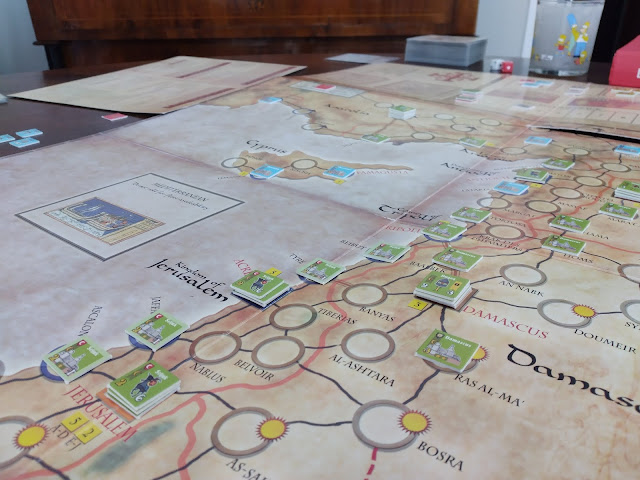Twilight Struggle. The Central American crisis
American: Laura Beltrami
Soviet: Alex Isabelle
We were camping at the Marmore Falls, an idyllic place if it weren't for the fact that, that day, a hellish downpour was coming down on us, and it kept us in the tent for the whole day. It would have been terrible if it weren't for the fact that we had Twilight Struggle with us. It was therefore decided to review the history of the Cold War.
The game begins with a first power struggle in Europe and the Middle East. The political game initially sees the United States respond to the economic crisis in Europe with the Marshall Plan, which opens the door to a shower of American influence in the old continent, and then allows the Americans to establish NATO. The blockade of Berlin in no way prevents the Americans from carrying out their projects. However, they are slowed down by the arrival of Charles de Gaulle at the helm of France. With his arrival the latter, already disputed between the two superpowers, definitively inclines towards a socialist guide. At the end of this first phase, Europe tends to be aligned with America, but three of its five main states have a socialist leadership. Consequently, it remains disputed.
The same happens in the Middle East, where Israel abandons American leadership and becomes neutral. Iraq and Syria accept Soviet funds and influence, but soon thereafter Iran takes a liberal turn, which aligns it with the United States. The arrival of Nasser, in Egypt, is late, and consequently this area also remains substantially disputed.
The scenario that quickly unbalances the game is instead Asia: here, initially, the Korean War ends in a stalemate. The Formosa Resolution is signed, and Japan enters into pacts with the United States that essentially transform them into their pawn. An American advantage seems to be taking shape, but within a few years the unthinkable happens: many European colonies in Southeast Asia become independent, and align themselves towards the Soviet axis. Soon after, China takes the field, with its important means of political influence: thus, South Korea embraces leftist ideas, and at the same time India turns out to be a socialist country. By nosing the danger, the United States extend their influence over Pakistan, but this is not enough to rebalance this chessboard, which hangs decisively towards the Soviets.
This does not interrupt the relevance of this scenario, which is scored again in the next round. The Russian victory is not far off: Europe, still disputed, and the Middle East, also count for something, but this time the Soviet influence is much more rooted in these territories. The United States try to develop their power in Africa, ignoring what happens in Central America: Fidel Castro takes control of Cuba, and a coup (one of the very few, in this game) overthrows the government of Panama, bringing it under the socialist wing. Immediately in Costa Rica the Communist Party takes power as well; this happens peacefully, while the Cuban missile crisis begins. US power, in these states just south of its border, is wiped out, and the timid attempt at a space race, with which America actually launches the first terrestrial satellite, is worthless. In fact, all the peoples of the Earth now recognize the supremacy of the socialist method and doctrine, and therefore the American empire collapses.
The new world power, at the end of the fourth game turn, is therefore the Soviet Union.
Do you want to read other stories? Click here for the full list.












Comments
Post a Comment